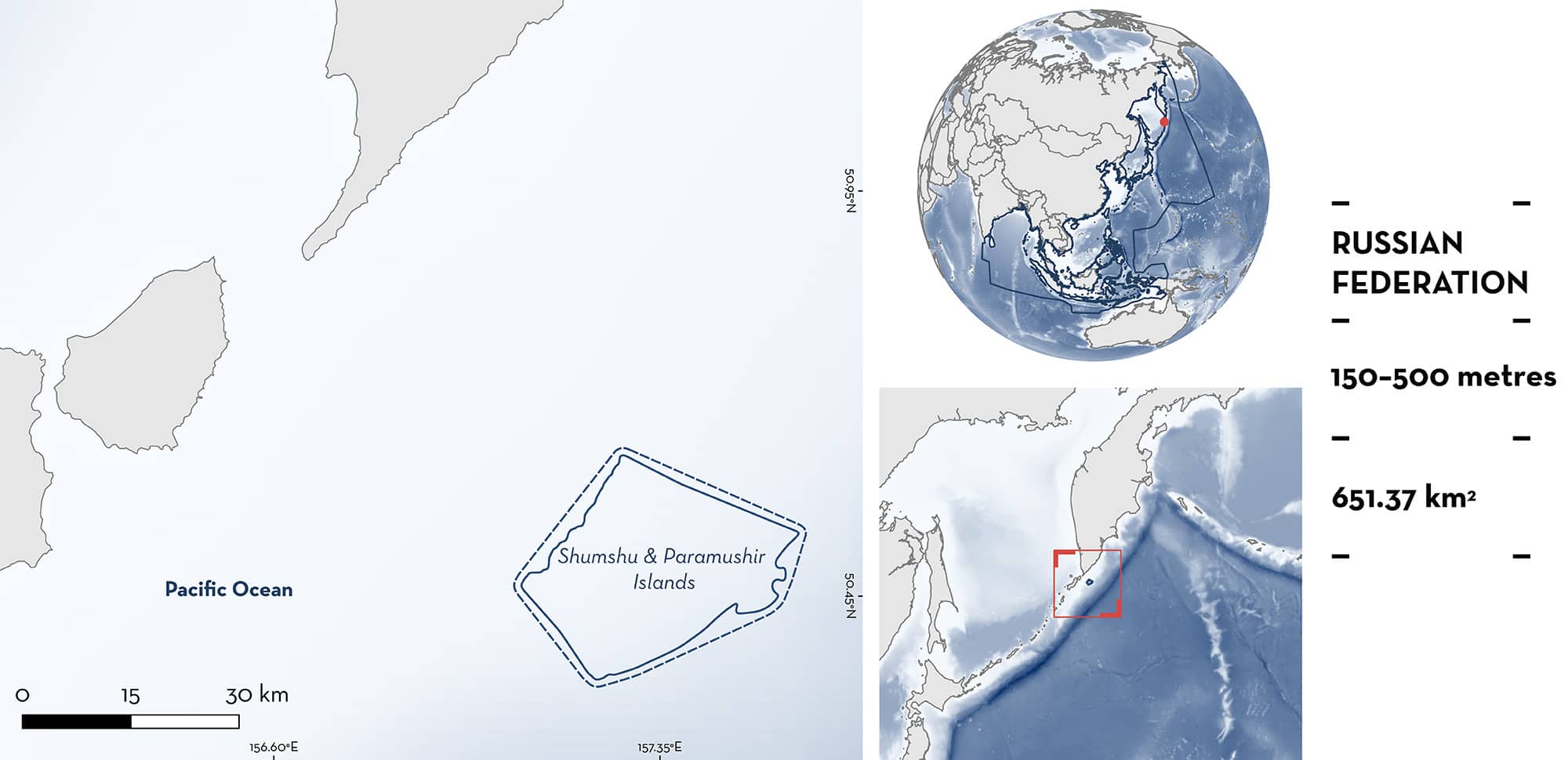ISRA FACTSHEETS
ISRA FACTSHEETS
ASIA REGION
Shumshu & Paramushir
Summary
Shumshu & Paramushir Islands is located within the northern Kuril Islands group, in the Russian Federation. The area is characterised by an extended shelf compared to the other Kuril Islands, by a relatively wide slope, and by its location between submarine canyons. Within this area there are: reproductive areas (e.g., Okhotsk Skate Bathyraja violacea).
Download factsheet
Shumshu & Paramushir
DESCRIPTION OF HABITAT
Shumshu & Paramushir Islands is located in the northern Kuril Islands group, in the Far Eastern Federal District of the Russian Federation. Paramushir is the largest of the northern Kuril Islands. It is bordered by the Sea of Okhotsk to the west and by the Pacific Ocean to the east. It is separated from Shumshu Island in the north by the Second Kuril Strait (~2 km wide). Shumshu Island is located south of the Kamchatka Peninsula and separated from it by the First Kuril Strait (~11 km wide). This area is characterised by an extended shelf compared to the other of the Kuril Islands. It also has a relatively gentle slope and is located between submarine canyons. The most important sources of sedimentary material in the area are continental and island erosion, wave abrasion and volcanism. As a result, wide zones of abrasive-accumulative leveling are present (Bezrukov 1955).
Changes in temperature and salinity are seasonally influenced. Within the shelf and the upper part of the slope of the Northern Kuril Islands, the largest range of changes in the vertical structure of waters is associated with cold and warm intermediate layers, the thickness of which varies from 75 to 150 m and from 270 to 500 m, respectively (Kantakov 2000).
This Important Shark and Ray Area is benthopelagic and subsurface and is delineated from 150 m to 500 m depth based on the depth range of the Qualifying Species in the area.
CRITERION C
SUB-CRITERION C1 – REPRODUCTIVE AREAS
Shumshu & Paramushir Islands is an important reproductive area for two ray species.
Scientific surveys using benthic trawls between 2010–2021 showed that aggregations of the Mud Skate and Okhotsk Skate regularly and predictably occur in this area (Orlov & Volvenko 2022, unpubl. data 2023).
This area holds the largest abundances of Mud Skates in Russian waters of the Northwest Pacific (mean = 664 individuals/km2, max = 3,003 individuals/km2; Orlov & Volvenko 2022, unpubl. data 2023). The largest abundances were found between March–September at 208–400 m depth (Orlov & Tokranov 2010; Orlov & Volvenko 2022). In August 2018, 518 Mud Skates were caught in the area in a single haul (Balanov et al. 2020). Size-at-birth is unknown for this species but 35% of the individuals in the haul had sizes between 14–20 cm total length (TL) which is close to the size-at-birth of other similar species (e.g., ~16 cm TL for the Bering Skate Bathyraja interrupta; Last et al. 2016) and far smaller than the reported size-at-maturity for the species (>53 cm TL; Last et al. 2016). In addition, the presence of yolk sac remnants indicated that these individuals were neonates while others were young-of-the-year, which was confirmed for a subset of individuals based on growth band readings (Shelekhov et al. 2022). This was the only haul out of 86 hauls where a large proportion of these smaller individuals was collected (Balanov et al. 2020; Panchenko et al. 2020). In addition, multiple egg cases with and without eggs and embryos were found in the same haul (Balanov et al. 2020). The distribution of adult aggregations overlapped with those of immature individuals for this species, contrary to the known spatial size-class segregation reported for other skates (Hoff 2008, 2016). Finally, small individuals (<20 cm TL) were also reported historically in the area between 1992–2002 (Orlov et al. 2006) confirming their regular presence and the presence of an important reproductive area.
This area also holds the largest abundances of Okhotsk Skate in Russian Waters of the Northwest Pacific (mean: 1,722 individuals/km2, max: 13,633 individuals/km2; Orlov & Volvenko 2022). The largest abundances were found between March–September at 149–500 m depth (Grigorov et al. 2017; Orlov & Volvenko 2022). In August 2018, 922 Okhotsk Skates were caught in the area in a single haul (Balanov et al. 2020). Size-at-birth is unknown for this species but 43% of the individuals in the haul had sizes between 14–20 cm TL which is close to the size-at-birth of another related species (~16 cm TL for the Bering Skate; Last et al. 2016). The presence of yolk sac remnants suggest that these were neonates and young-of-the-year. In addition, multiple egg cases with and without eggs and embryos were found in the same haul. Adult aggregations overlapped with these smaller individuals, contrary to the spatial size-class segregation reported for other skates (Hoff 2008, 2016). In 2005, two females with egg-capsules ready for deposition (horns protruding from the cloaca), were found in the same area (Orlov & Biryukov 2005). Small individuals (<20 cm TL) were reported previously in the area between 1993–2010 (Orlov et al. 2006; Grigorov et al. 2017) confirming their regular presence and the presence of an important reproductive area.
Download factsheet
SUBMIT A REQUEST
ISRA SPATIAL LAYER REQUEST
To make a request to download the ISRA Layer in either a GIS compatible Shapefile (.shp) or Google Earth compatible Keyhole Markup Language Zipped file (.kmz) please complete the following form. We will review your request and send the download details to you. We will endeavor to send you the requested files as soon as we can. However, please note that this is not an automated process, and before requests are responded to, they undergo internal review and authorization. As such, requests normally take 5–10 working days to process.
Should you have questions about the data or process, please do not hesitate to contact us.


